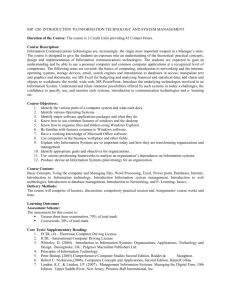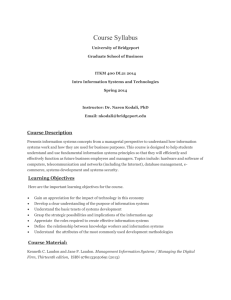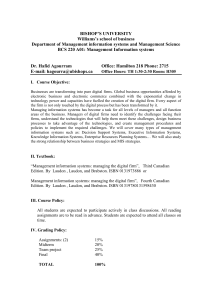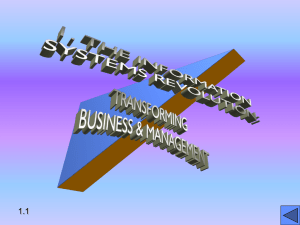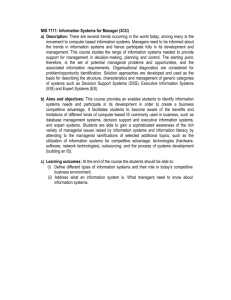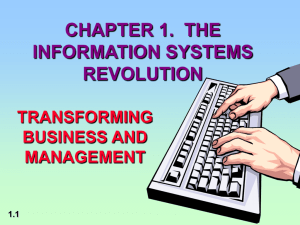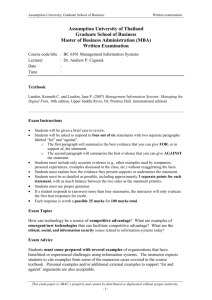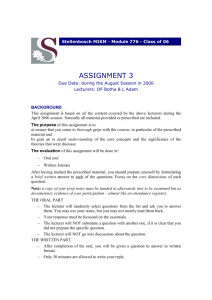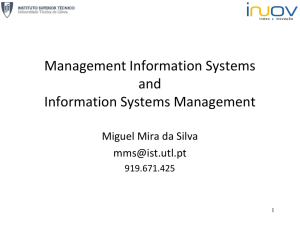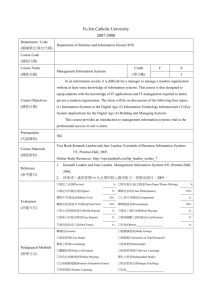Organizations, Management and the Networked Enterprise
advertisement
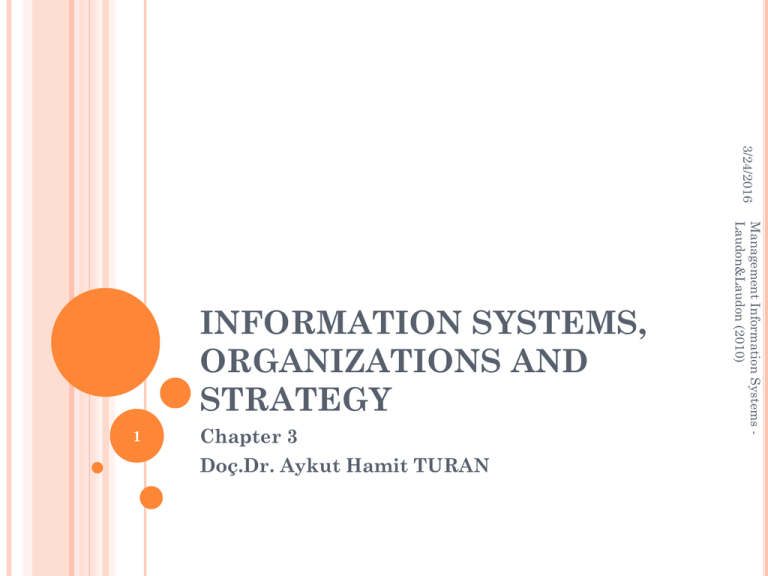
3/24/2016 1 Chapter 3 Doç.Dr. Aykut Hamit TURAN Management Information Systems Laudon&Laudon (2010) INFORMATION SYSTEMS, ORGANIZATIONS AND STRATEGY THE US AIRWAYS MERGER Management Information Systems Laudon&Laudon (2010) The US Airways merger illustrates the interdependence of business environments, organizational culture, business processes, business strategy and the development of IS The merging companies have different organizational structures, cultures, business processes and IS, which had to be integrated for the company to run effectively US Airways was traditional hub and spoke carrier with an older workforce, lumbering bureucracy and rigid IS function that had been outsourced to EDS. American West was very different, formed in 1981, it had younger workforce, more freewheeling enterpreneour culture and a penchant for managing its own IS By late 1990s, they both are considered airlines of last resort, people flew when they are no other alternatives 3/24/2016 2 THE US AIRWAYS MERGER After the merger, airlines aimed to reduce costs by eliminating redundant IS and adopting simple, flexible IS and business functions of American West The new US is now fifth largest carrier in US and world’s largest low cost carrier Success depends on how well the two companies’ systems and business processes are integrated Significant challanges in consolidating functions, integrating organizations, procedures and operations will make the integration of two airlines costly, complex and time consuming Management Information Systems Laudon&Laudon (2010) Merger was designed to create synergy between traditional full service airline and a newer low cost carrier with US Airline’s experience and strong network on the east coast and American West’s low cost structure, IS and routes in the western US 3/24/2016 3 THE US AIRWAYS MERGER There is interdependence of business environments, organizational culture, business processes, business strategy and the development of IS Mergers are a response to competitive forces and pressures to surronding environment The merging companies have different organizational cultures, business processes and IS, which had to be integrated for the new company run efficiently Management Information Systems Laudon&Laudon (2010) 3/24/2016 4 ORGANIZATIONS AND INFORMATION SYSTEMS IS and organizations influence one another IS is built to serve the interests of organizations Organizations must be aware of and open to the influences of IS to benefit from new technologies The interaction between IT and organization is complex and is influenced by many mediating factors, including organization’s structure, business processes, politics, culture, surrounding environment and management decisions We need to understand how IS can change social and work life in our firms Some of the changes that occur in business firms because of new IT investments cannot be foreseen and have results that may or may not meet our expectations – email’s prodominance in business world Management Information Systems Laudon&Laudon (2010) 3/24/2016 5 ORGANIZATIONS AND INFORMATION SYSTEMS 3/24/2016 Management Information Systems Laudon&Laudon (2010) 6 WHAT IS AN ORGANIZATION Management Information Systems Laudon&Laudon (2010) An organization is a stable, formal social structure that takes resources from the environment and process them to produce outputs Organization transforms inputs into products and services in a production function Organizations are formal legal entities with internal rules and procedures that must abide by laws Organizations are also social structures because they are a collection of social elements In the behavioral view of organization, organization is seen as a collection of rights, privileges, obligations and responsibilities that is delicately balanced over a period of time through conflict and conflict resolution 3/24/2016 7 WHAT IS AN ORGANIZATION Management Information Systems Laudon&Laudon (2010) An organization is more stable than an informal group in terms of longetivety and routiness In this behavioral view of the firm, people who work in organization develop customary ways of working, they gain attachmenets to exisiting relationships and they make arrangements with subordinates and superiors about how the work to be done and under what conditions to be done A technical view of organization encourages us to focus on how inputs are combined to create outputs when technology changes are introduced into the company. In behavioral view, building new IS or rebuilding exisiting ones require much more than technical arrangements of machines and workers. Some IS changes organizational balance of rights, privilages, obligations, responsibilities and feelings 3/24/2016 8 WHAT IS AN ORGANIZATION Management Information Systems Laudon&Laudon (2010) Changing these elements can take a long time, very distruptive and require more resources to support training and learning Technological change require changes in who owns and controls information, who has the right to access and update the information, and who makes decisions about whom, when and how Technical and behavioral view of organizations compliment each other The technical view tells us how firms in competitive markets combine capital, labor and IS, whereas behavioral model takes us inside of individual firm to see how technology affects the organization’s inner workings 3/24/2016 9 TECHNICAL VIEW OF ORGANIZATION 3/24/2016 Management Information Systems Laudon&Laudon (2010) 10 THE BEHAVIORAL VIEW OF ORGANIZATION 3/24/2016 Management Information Systems Laudon&Laudon (2010) 11 FEATURES OF ORGANIZATION Management Information Systems Laudon&Laudon (2010) All modern organizations have certain characteristics They are bureaucracies with clear cut divisions of labor and specialization Organizations arrange specialities in a hierarchy of authority in which everyone is accountable to someone and authority is limited to specific actions governed by abstract rules and procedures The organization is devoted to the principle of efficiency: maximizing output using limited inputs Other features of organization include their business processes, organizational culture, organizational politics, surrounding environments, structure goals, constituencies and leadership styles 3/24/2016 12 ROUTINES AND BUSINESS PROCESSES Management Information Systems Laudon&Laudon (2010) All organizations become very efficient over time because individuals in the firm develop routines for producing goods and services Routines are also called standard operating procedures and practices that have been developed to cope with virtually all expected situations As employees learn these routines, they become very efficient and highly productive and firm is able to reduce costs over time as efficiency increases Combination of routines makes businss processes 3/24/2016 13 ORGANIZATIONAL POLITICS 3/24/2016 Management Information Systems Laudon&Laudon (2010) People in organizations occupy different positions with different specialties, concerns and perspectives They naturally have divergent viewpoints about how resources, rewards and punishments should be distributed Political resistance is one of the great difficulties of bringing about organizational change, especially the development of new IS Virtually all large IS investments bring about significant changes in strategy, business objectives and business procedures 14 ORGANIZATIONAL CULTURE Generally these cultural assumptions are taken for granted and rarely publicly spoken or announced Organizational culture is a very powerful restraint on change, especially technological change Organizational culture is a powerful unifying force that restrains political conflict and promotes common understanding, agrement on procedures and common practices Most organizations will do anything to avoid changes on common practices and assumptions Any technological change that bring challenge commonly held cultural assumptions usually meets great deal of resistance Management Information Systems Laudon&Laudon (2010) Organizational culture encompasses set of assumptions about what products the organization should produce, how it should produce them, where and for whom 3/24/2016 15 ORGANIZATIONAL ENVIRONMENTS Management Information Systems Laudon&Laudon (2010) Organizations reside in environments from which they draw resources and to which they supply goods and services Organizations are open to and dependent on the social and political environment that surrounds them Organizations must respond to legislative and other requirements imposed by government Information systems are key instruments for environmental scanning, helping managers identify external changes that might require an organizational response The main reasons for organizational failure are an inability to adapt faster to rapidly changing environments and lack of resources 3/24/2016 16 ORGANIZATIONAL ENVIRONMENTS Management Information Systems Laudon&Laudon (2010) IS are key instruments for environmental scanning, helping managers idetify external changes that might require an organizational response Environments generally change much faster than organizations The main reason for organizational failure is inability to respond changing environments and lack of resources, particulaly among young firms to sustain even short periods of troubled times New technologies, new products and changing public tastes and values put restrains on organizational culture, politics and people Most organizations cannot deal with large environmental shifts 3/24/2016 17 ORGANIZATIONAL STRUCTURES Management Information Systems Laudon&Laudon (2010) All organizations have a structure and shape Mintzberg defined organizational structures in five types The kind of IS you find in a business firm and the nature of problems with these systems reflects the types of organizational structures. For example in a professional bureucracy like an hospital, it is not unusual to find paralel patient record system, one operated by administration, another by doctors and another by professional staff like nurses and social workers 3/24/2016 18 MINTZBERG’S ORGANIZATIONAL STRUCTURES 3/24/2016 Management Information Systems Laudon&Laudon (2010) 19 OTHER ORGANIZATIONAL FEAUTURES Management Information Systems Laudon&Laudon (2010) Organizations have goals and use different means to achieve them Some organizations must have coercive goals like prisons, others have utilitarian goals like businesses. Some others have normative goals like universities, religeous groups Organizations also serve different groups, some primarily benefitting their members, others benefitting clients, stockholders or public Organizations may have different lieadership styles as well. Some may be more democratic, some may be more authoriterian than others Some organizations operate on routine tasks, whereas other such as consulting firms work primarily on non routine tasks 3/24/2016 20 HOW IS IMPACT ORGANIZATIONS AND BUSINESS FIRMS Management Information Systems Laudon&Laudon (2010) IS have become integral, online, interactive tools deeply involved in the minute to minute operations and decision making of large organizations Over the last decade, IS have fundamentally altered the economics of organizations and greatly increased possibilities for organizing work 3/24/2016 21 ECONOMIC IMPACTS IS can be viewed as a factor of production that can be substituted for traditional capital and labor As the cost of IT decreases, it is substituted for labor As cost of IT decreases, it also substitutes for other forms of capital, such as buildings and machinery IT should also result in a decline in the number of middle managers and clerical workers as IT substitudes for labor IT helps firms contrast in size because it can reduce transaction costs – the cost incurred when firms buy on the marketplace what it cannot make itself IT, the use of networks can help firms lower the cost market participation IT also reduce internal management costs, It also enable managers to oversee a greater number of employees Management Information Systems Laudon&Laudon (2010) IT changes both the relative costs of capital and the costs of information 3/24/2016 22 ECONOMIC IMPACTS Cost of locating and communicating with distant suppliers, monitoring contract complience, buying insurence, obtaining information on products are expensive Traditionally firms try to reduce transaction costs by getting bigger, hiring more employees and buying their own suppliers and distributors IT, especially use of networks can help firms lower the cost of market participation (transaction costs), making it worthwhile for firms to contach external suppliers instead using internal resources IT can also reduce internal management costs. According to agency theory, the firm is viewed as a nexus of contracts among self interested individuals rather than unified, profit maximizing entity Management Information Systems Laudon&Laudon (2010) According to transaction cost theory, firms and individuals seek to economize on transaction costs, much as they do on production costs 3/24/2016 23 ECONOMIC IMPACTS As companies grow in size and scope, cost of supervising and managing – agency costs will increase IS can reduce of cost of acquiring and analyzing information by permitting to reduce agency costs since managers can oversee a greater number of employees IT enables firms to increase revenues by shrinking the number of middle managers and clerical workers Management Information Systems Laudon&Laudon (2010) A principal employs agents to perform the work. However, agents need constant supervision and management, otherwise they would tend to pursue their own interests rahther than those of owners 3/24/2016 24 ORGANIZATIONAL AND BEHAVIORAL IMPACTS IT flattens organizations Management Information Systems Laudon&Laudon (2010) Large organizations often inefficient, slow to change and less competitive than newly created organizations IT facilitates and broadens distribution of information to empower lower level employees and increase management efficiencies IT pushes decision making rights lower in organization Management span of control has also been broaden, enabling high level managers to manage and control more workers spread over greater distances 3/24/2016 25 ORGANIZATIONAL AND BEHAVIORAL IMPACTS 3/24/2016 Management Information Systems Laudon&Laudon (2010) 26 ORGANIZATIONAL AND BEHAVIORAL IMPACTS Postindustrial Organizations Management Information Systems Laudon&Laudon (2010) In postindustrial societies, authority increasingly relies on knowledge and competence and not merely on formal positions Organizations become more decentralized and information become more widespread throughout the organization IT may encourage task force networked organizations in which group of professionals come together for short period of times to accomplish specific tasks 3/24/2016 27 ORGANIZATIONAL AND BEHAVIORAL IMPACTS Postindustrial Organizations Management Information Systems Laudon&Laudon (2010) IT enables task groups to work face to face or electronically to accomplish specific tasks IT also enables to form self managed teams But who makes sure that self managed teams do not head off in the wrong direction? Who decides which person works on which team and how long? How can manager evaluate the performance of someone who is constantly rotating from team to team? New approaches for evaluating, organizing and informing workers are required not all companies can make virtual work effective 3/24/2016 28 ORGANIZATIONAL AND BEHAVIORAL IMPACTS Understanding organizational resistance to change Management Information Systems Laudon&Laudon (2010) IT inevitably become bound up in organizational politics because they influence access to a key resource – Information IS can affect who does what to whom, when, where and how in the organization New IS require changes in personal, individual routines that can be painful for those involved and require retraining and additional effort that may or may not be compensated In Leavitt’s model, the only way to bring change is to change the technology, tasks, structure and people simultaneously 3/24/2016 29 ORGANIZATIONAL AND BEHAVIORAL IMPACTS Understanding organizational resistance to change Management Information Systems Laudon&Laudon (2010) Because IS potentially change an organization’s structure, culture, business processes and strategy, there is often considerable resistance to them when they are introduced Because organizational resistence to change is so powerful, many IT investments flounder and do not increase productivity Most reasons of failures of IS projects is not because of technology, but organizational and politic resistance to change 3/24/2016 30 LEAVITT’S CHANGE MODEL 3/24/2016 Management Information Systems Laudon&Laudon (2010) 31 INTERNET AND ORGANIZATIONS Management Information Systems Laudon&Laudon (2010) Internet is beginning to have an important impact on the relationships between firms and external entities and even on organization of business processes inside firm Internet increases the accessibility, storage and distribution of information and knowledge for organizations Internet can dramatically reduce transaction and agency costs Businesses are rapidly rebuilding some of their key business processes based on Internet technology and making this technology key component of their IT infrastructure 3/24/2016 32 IMPLICATIONS FOR THE DESIGN AND UNDERSTANDING OF IS The central organizational factors to consider when planning a new systems are The environment in which organization function The structure of organization The organizational culture and politics The type of organization and its style of leadership The principal interests groups affected by the system and attitudes of workers using the systems The kind of tasks, decisions and business processes that IS is designed to assists Management Information Systems Laudon&Laudon (2010) 3/24/2016 33 USING IS TO ACHIEVE COMPETITIVE ADVANTAGE In all industries, some firms do better than others Firms that do better than others said to have competitive advantage Either have access to special resources that other do not, or these firms are able to use commonly available resources more efficiently, usually because of their superior knowledge and information assests Management Information Systems Laudon&Laudon (2010) Apple ITunes Toyota 3/24/2016 34 PORTER’S COMPETITIVE FORCES MODEL 3/24/2016 Management Information Systems Laudon&Laudon (2010) The most widely used competitive model – Competitive Advantage Model The model provides a general view of the firm, its competitors and the firm’s environment Traditional Competitors: All firms share market space with other competitors who are continuously devising new, more efficient ways to produce by introducing new services and products New Market Entrants: In a free economy with mobile labor and financial resources, new companies are always entering the marketplace 35 PORTER’S COMPETITIVE FORCES MODEL Substitute Products and Services: In just about every industry, there are substitutes that your customers might use if prices become too high Customers: A profitable company depends in large measure on its ability to attract and retain customers and charge high prices The power of customers grow if they can easily switch to a competitor’s products and services In a transparent markets, where prices known instantly and there is low product differentiation, customers’ power increases Suppliers: The market power of suppliers can have a significant impact on firm profit, especially when the firm cannot raise prices as fast as can suppliers Management Information Systems Laudon&Laudon (2010) In some industries, entry is very difficult, in some it is very easy 3/24/2016 36 PORTER’S COMPETITIVE FORCES MODEL 3/24/2016 Management Information Systems Laudon&Laudon (2010) 37 IS STRATEGIES FOR DEALING WITH COMPETITIVE FORCES Management Information Systems Laudon&Laudon (2010) Use IS to achieve the lowest operational costs and the lower prices Wal Mart’ s continuous replenishment systems An efficient customer response system directly links customer behavior to distribution and production and supply chains 3/24/2016 There are four generic strategies, each of which enabled by using IS Low cost leadership Product differentiation Use IS to enable new products and services Google continuously introducing new products and services 38 IS STRATEGIES FOR DEALING WITH COMPETITIVE FORCES Strengthen customer and supplier intemacy Use of IS to tighten linkages with suppliers and develop intimacy with customers. Crysler Corp allows suppliers more lead time in producing goods. Amazon.com keeping user preferences for books and CDs, recommends products and services Strong linkages to customers and suppliers increase switching costs and loyalty to our firm Management Information Systems Laudon&Laudon (2010) Focus on market niche Use IS to enable a specific market focus and serve this narrow market better than competitors IS support this strategy by producing and analyzing data for finely tuned sales and marketing techniques, customers’ buying patterns, tastes and preferences closely to efficiently pitch market advertising and marketing campaigns to smaller and smaller target markets 3/24/2016 39 SUPPLY CHAIN MANAGEMENT SYSTEMS Management Information Systems Laudon&Laudon (2010) Help businesses manage their relationships with their customers Provide information to help suppliers, purchasing firms, distributors and logistic companies share information about orders, production levels and delivery of products and services efficiently If company and its supply network do not have accurate information, they will most likely be dealing with excessive inventories and problems in deliveries of inventories and products SCMS are inter-organizational systems because they automate the flow of information across organizational boundaries 3/24/2016 40 IS STRATEGIES FOR DEALING WITH COMPETITIVE FORCES Focus on Market Niche Use IS to enable a specific market focus, and serve this narrow target market better than competitors IS support this strategy by producing and analyzing data for finely tuned sales and marketing techniques Strengthen Customer and Supplier Intimacy Use IS to tighten linkages with suppliers and develop intimacy with customers Amazon.com keeps track of user preferences for book and CD purchases and can recommend titles purchased by others Strong linkages to customers and suppliers increase switching costs and loyalty to your firm Management Information Systems Laudon&Laudon (2010) Product differentiation Mass customization is the ability to offer individually tailored products or services using the same production resources as mass production 3/24/2016 41 INTERNET’S IMPACT ON COMPETITIVE ADVANTAGE Management Information Systems Laudon&Laudon (2010) The Internet has nearly destroyed some industries and has severely threatened more The Internet has also created entirely new markets and formed the basis for thousands of new businesses Music, Air travel industries, telephone services Emerging new business models Because of the Internet, the traditional forces are still at work, but competitive rivalry has become much more intense 3/24/2016 42 INTERNET’S IMPACT ON COMPETITIVE FORCES 3/24/2016 Management Information Systems Laudon&Laudon (2010) 43 THE BUSINESS VALUE CHAIN MODEL Management Information Systems Laudon&Laudon (2010) The value chain model highlights specific activities in the business where competitive strategies can best be applied and where IS are most likely to have strategic impact The value chain model views the firm as a series or chain of basic activities that add margin of value to a firm’s products and services Primary activities are most directly related to the production and distribution of the firm’s product and services, which create value for customers Support activities make the delivery of the primary activities possible and consist of organizational structure 3/24/2016 44 THE BUSINESS VALUE CHAIN MODEL 3/24/2016 Management Information Systems Laudon&Laudon (2010) 45 SYNERGIES, CORE COMPETENCIES AND NETWORK BASED STRATEGIES Management Information Systems Laudon&Laudon (2010) A large corporation is typically a collection of businesses Often, the firm is organized financially as a collection of strategic business units and the returns to the firm are directly tied to the performance of all strategic business units Synergies: IS can tie operations and business units so that they can act as a whole A core competency is an activity for which a firm is a world class leader The availability of Internet and networking technologies has inspired strategies that take advantage of firms’ abilities to create networks or network with each other 3/24/2016 46 USING SYSTEMS FOR COMPETITIVE ADVANTAGE Management Information Systems Laudon&Laudon (2010) Strategic IS often change the organization as well as its products, services and operating procedures, driving the organization into new behavioral patterns The competitive advantages strategic systems confer do not necessarily last enough to ensure long term profitability The Internet can make competitive advantage disappear very quickly because virtually all companies can use this technology Adopting the kinds of strategic systems generally require changes in business goals, relationships with customers and suppliers and business processes Such changes often entail blurring of organizational boundaries, both external and internal 3/24/2016 47
